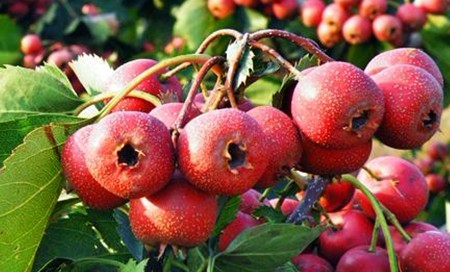Crataegus pinnatifida, also known as Chinese hawthorn, refers to a small to a medium-sized tree as well as the fruit of the tree. The fruit is bright red, 1.5 inches in diameter.
Trees deciduous, to 6 m tall, with thorns 1–2 cm or sometimes unarmed. Branchlets purplish brown when young, grayish brown when old, terete, subglabrous or glabrous when young; buds purplish red, triangular-ovoid, glabrous. Stipules falcate, ca. 8 mm, herbaceous, margin serrate, apex acuminate; petiole 2–6 cm, glabrous; leaf blade dark green adaxially, broadly ovate or triangular-ovate, rarely rhomboidal-ovate, 5–10 × 4–7.5 cm, lateral veins 6–10 pairs, usually extending to apices of lobes and to sinuses between lobes, abaxially sparsely pubescent along veins, adaxially lustrous, base truncate or broadly cuneate. In northern Chinese cuisine, ripe Crataegus pinnatifida fruits are used in the dessert tanghulu. It is also used to make the traditional haw flakes, as well as candied fruit slices, jam, jelly and wine.
| Catalog | Product Name | CAS Number | Manual |
|---|---|---|---|
| CFN98669 | Crategolic acid | 4373-41-5 | |
| CFN99139 | Glucosylvitexin | 76135-82-5 | |
| CFN98177 | Vitexin-2''-O-rhamnoside | 64820-99-1 | |
| CFN92072 | Vitexin -4''-O-glucoside | 178468-00-3 | |
| CFN98843 | Apigenin | 520-36-5 | |
| CFN98838 | Kaempferol | 520-18-3 | |
| CFN98784 | Luteolin | 491-70-3 | |
| CFN98601 | Vitexin | 3681-93-4 | |
| CFN99272 | Quercetin | 117-39-5 | |
| CFN98551 | Citric acid | 77-92-9 | |
| CFN99116 | Chlorogenic acid | 327-97-9 | |
| CFN99716 | Palmitic acid | 57-10-3 | |
| CFN93165 | Stearic Acid | 57-11-4 | |
| CFN94800 | Oleic acid | 112-80-1 | n/a |
| CFN93168 | Linoleic acid | 60-33-3 | |
| CFN98800 | Oleanolic acid | 508-02-1 | |
| CFN98685 | Corosolic acid | 4547-24-4 | |
| CFN97259 | Ursolic acid | 77-52-1 | |
| CFN99100 | Succinic acid | 110-15-6 |
A unique collection of 23 natural compounds from Peucedanum praeruptorum Dunn
A unique collection of 28 natural compounds from Taxus cuspidata Sieb. Et Zucc.
A unique collection of 24 natural compounds from Zingiber officinale Roscoe
A unique collection of 29 natural compounds from Lonicera japonica Thunb.
A unique collection of 37 natural compounds from Lycium chinense
A unique collection of 21 natural compounds from Aucklandia lappa
A unique collection of 24 natural compounds from Angelica acutilobac (Sieb. et Zucc.) Kitag.





